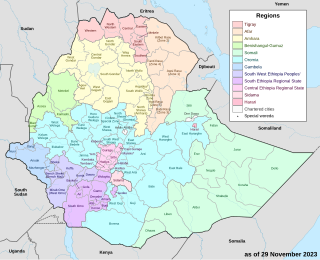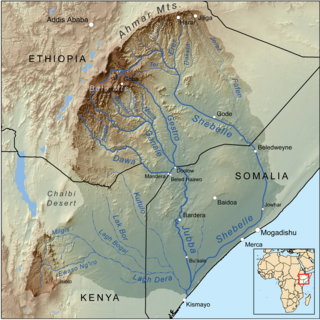 W
WThe Bale Mountains, in the Oromia Region of southeast Ethiopia, south of the Awash River, are part of the Ethiopian Highlands. They include Tullu Demtu, the second-highest mountain in Ethiopia, and Mount Batu. The Weyib River, a tributary of the Jubba River, rises in these mountains east of Goba. The Bale Mountains National Park covers 2,200 square kilometers of these mountains. The main attractions of the park are the wild alpine scenery, and the relative ease with which visitors can see unique birds and mammals.
 W
WBale Mountains National Park (BMNP) is a national park in Ethiopia. The park encompasses an area of approximately 2,150 square kilometres in the Bale Mountains and Sanetti Plateau of the Ethiopian Highlands.
 W
WEricabatrachus is a genus of frogs in the family Petropedetidae endemic to the Bale Mountains in Ethiopia. It is monotypic, being represented by the single species Ericabatrachus baleensis, commonly known as the Bale Mountains frog,.
 W
WThe Bale shrew is a species of mammal in the family Soricidae.
 W
WBale is one of the zones in the Oromia Region of Ethiopia. Bale is named for the former Sultanate of Bale, which was in approximately the same area.
 W
WMount Batu is one of the highest of the Bale Mountains of Ethiopia, as well as of the Oromia Region. Part of the Bale National Park, and located at 06°40′N 39°25′E, it reaches an elevation of 4,307 meters. It consists of two peaks, Tinnish Batu, which is actually higher than Tilliq Batu to the south. The reason for these deceptive names is explained by Paul Henze, who reports that upon viewing them, "it appeared that the peak behind Tinnish Batu was definitely higher."
 W
WThe big-headed African mole rat,, also known as the giant root-rat, Ethiopian African mole rat, or giant mole rat, is a rodent species in the family Spalacidae. It is endemic to Ethiopia's Bale Mountains. Its natural habitat is subtropical or tropical high-altitude grassland, where it can reach densities of up to 2,600 individuals per square kilometre. It is threatened by habitat loss. Where the two species overlap, it is the main prey of the endangered Ethiopian wolf.
 W
WCoffea arabica, also known as the Arabian coffee, "coffee shrub of Arabia", "mountain coffee" or "arabica coffee", is a species of Coffea. It is believed to be the first species of coffee to be cultivated, and is the dominant cultivar, representing about 60% of global production. Coffee produced from the robusta bean makes up most of the remaining coffee production. Arabica coffee was first found in Yemen and documented by the 12th century. Coffea arabica is called بُنّ in Arabic, borrowed from the.
 W
WDinsho is a village in south-central Ethiopia. Located in the Bale Zone of the Oromia Region in the heart of the Bale Mountains, this village has a latitude and longitude of 7°05′N 39°45′E and an elevation of 3207 meters. It is the administrative center of Dinsho woreda.
 W
WEricabatrachus is a genus of frogs in the family Petropedetidae endemic to the Bale Mountains in Ethiopia. It is monotypic, being represented by the single species Ericabatrachus baleensis, commonly known as the Bale Mountains frog,.
 W
WThe Ganale Doria River is a perennial river in southeastern Ethiopia. Rising in the mountains east of Aleta Wendo, the Ganale flows south and east to join with the Dawa at the border with Somalia to become the Jubba. The river's tributaries include the Welmel, Weyib, Dumale, Doya, Hawas and the Hambala. The Del Verme Falls is a notable feature of its middle course.
 W
WThe Harenna Forest is located in a highland forest region of the Bale Mountains, in the Oromia Region of southeastern Ethiopia.
 W
WThe Harenna shrew is a white-toothed shrew found only in one location in the Bale Mountains in southern Ethiopia. It occurs within an area of less than ten square kilometres, and is listed as a critically endangered species, due to habitat loss and a restricted range.
 W
WLobelia rhynchopetalum, the giant lobelia, is a plant endemic to Ethiopia. Its habitat is the Afroalpine climate of the Semien Mountains and Bale Mountains National Park. Recent study show that it is under a threat of climate change.
 W
WTullu Dimtu is the fourth highest peak in Ethiopia after Ras Dashen (4550m), Ancua (4462m), and Kidus Yared (4453m).
 W
WThe mountain nyala or balbok is an antelope found in high altitude woodland in a small part of central Ethiopia. It is a monotypic species first described by English naturalist Richard Lydekker in 1910. The males are typically 120–135 cm (47–53 in) tall while females stand 90–100 cm (35–39 in) at the shoulder. Males weigh 180–300 kg (400–660 lb) and females weigh 150–200 kg (330–440 lb). The coat is grey to brown, marked with two to five poorly defined white strips extending from the back to the underside, and a row of six to ten white spots. White markings are present on the face, throat and legs as well. Males have a short dark erect crest, about 10 cm (3.9 in) high, running along the middle of the back. Only males possess horns.
 W
WThe Sanetti Plateau is a major plateau landform of the Ethiopian Highlands, located in the Oromia Region of Ethiopia
 W
WThe Shebelle River begins in the highlands of Ethiopia, and then flows southeast into Somalia towards Mogadishu. Near Mogadishu, it turns sharply southwest, where it follows the coast. Below Mogadishu, the river becomes seasonal. During most years, the river dries up near the mouth of the Jubba River, while in seasons of heavy rainfall, the river actually reaches the Jubba and thus the Somali Sea.
 W
WThe Bale Mountains, in the Oromia Region of southeast Ethiopia, south of the Awash River, are part of the Ethiopian Highlands. They include Tullu Demtu, the second-highest mountain in Ethiopia, and Mount Batu. The Weyib River, a tributary of the Jubba River, rises in these mountains east of Goba. The Bale Mountains National Park covers 2,200 square kilometers of these mountains. The main attractions of the park are the wild alpine scenery, and the relative ease with which visitors can see unique birds and mammals.
 W
WThe Bale Mountains vervet is a terrestrial Old World monkey endemic to Ethiopia, found in the bamboo forests of the Bale Mountains. All species in Chlorocebus were formerly in the genus Cercopithecus. The Bale Mountains vervet is one of the least-known primates in Africa. They avoid tree-dominated and bushland areas as their habitat. These monkeys mainly reside in the bamboo forest of the Bale Mountains due their dietary specialization on bamboo, but other factors, such as climate, forest history, soil quality, and disease, are likely to play a role in their choice to inhabit this area. The Bale Mountains vervet have a very quiet behavior and tend to flee when encountering a human being. It is also known as the Bale monkey.
 W
WWeyib River is a river of eastern Ethiopia. It rises in the Bale Mountains east of Goba in the Oromia Region, flowing east to pass through the Sof Omar Caves, then to the southeast until it joins the Ganale Dorya River in the Somali Region.